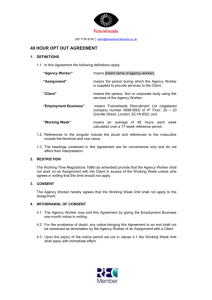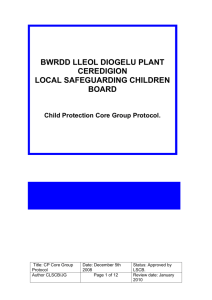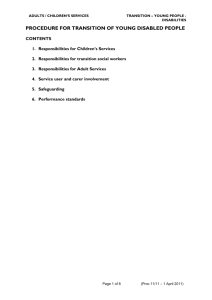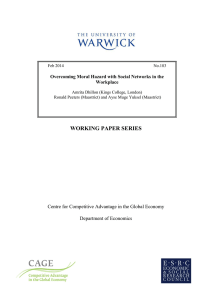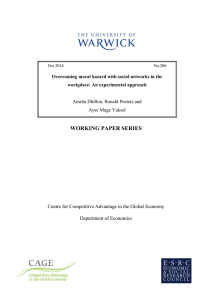The single assessment is being introduced in Gloucestershire on
advertisement
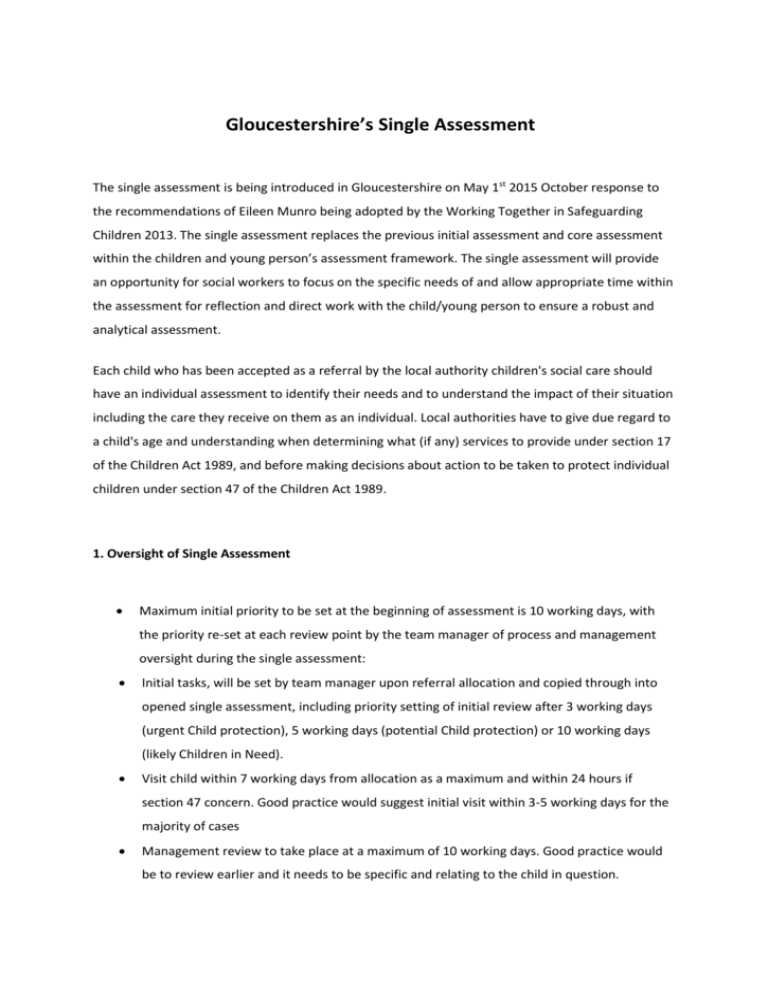
Gloucestershire’s Single Assessment The single assessment is being introduced in Gloucestershire on May 1st 2015 October response to the recommendations of Eileen Munro being adopted by the Working Together in Safeguarding Children 2013. The single assessment replaces the previous initial assessment and core assessment within the children and young person’s assessment framework. The single assessment will provide an opportunity for social workers to focus on the specific needs of and allow appropriate time within the assessment for reflection and direct work with the child/young person to ensure a robust and analytical assessment. Each child who has been accepted as a referral by the local authority children's social care should have an individual assessment to identify their needs and to understand the impact of their situation including the care they receive on them as an individual. Local authorities have to give due regard to a child's age and understanding when determining what (if any) services to provide under section 17 of the Children Act 1989, and before making decisions about action to be taken to protect individual children under section 47 of the Children Act 1989. 1. Oversight of Single Assessment Maximum initial priority to be set at the beginning of assessment is 10 working days, with the priority re-set at each review point by the team manager of process and management oversight during the single assessment: Initial tasks, will be set by team manager upon referral allocation and copied through into opened single assessment, including priority setting of initial review after 3 working days (urgent Child protection), 5 working days (potential Child protection) or 10 working days (likely Children in Need). Visit child within 7 working days from allocation as a maximum and within 24 hours if section 47 concern. Good practice would suggest initial visit within 3-5 working days for the majority of cases Management review to take place at a maximum of 10 working days. Good practice would be to review earlier and it needs to be specific and relating to the child in question. After the first review (max 10 working days), a single assessment will need a second review if it is going to extend beyond 25 working days – to be clear of why and what impact upon the child. Maximum timescale is 45 working days (although this will not stand for specified documents, ie. Court reports within SA framework) Key to note that some single assessments will be expected to be completed and finalised at the 10 working day point. 2. Focus on the Child Children should to be seen and listened to and included throughout the assessment process. Their ways of communicating should be understood in the context of their family and community as well as their behaviour and developmental stage. Assessments, service provision and decision making should regularly review the impact of the assessment process and the services provided on the child so that the best outcomes for the child can be achieved. Any services provided should be based on a clear analysis of the child’s needs, and the changes that are required to improve the outcomes for the child. Children should be actively involved in all parts of the process based upon their age, developmental stage and identity. Direct work with the child and family should include observations of the interactions between the child and the parents/care givers. All agencies involved with the child, the parents and the wider family have a duty to collaborate and share information to safeguard and promote the welfare of the child. 2. Planning All assessments should be planned and coordinated by a social worker and the purpose of the assessment should be transparent, understood and agreed by all participants. There should be an agreed statement setting out the aims of the assessment process. Planning should identify the different elements of the assessment including who should be involved. It is good practice to hold a planning meeting to clarify roles and timescales as well as services to be provided during the assessment where there are a number of family members and agencies likely to play a part in the process. Questions to be considered in planning assessments include: What is the assessment for? Who will undertake the assessment and what resources will be needed? Who in the family will be included and how will they be involved (including absent or wider family and others significant to the child)? A genogram is a useful tool to plan this. In what grouping will the child and family members be seen and in what order and where? What services are to be provided during the assessment? Are there communication needs? If so, what are the specific needs and how they will be met? How will the assessment take into account the particular issues faced by black and minority ethnic children and their families, and disabled children and their families? What method of collecting information will be used? Are there any tools / questionnaires available? What information is already available? What other sources of knowledge about the child and family are available and how will other agencies and professionals who know the family be informed and involved? How will the consent of family members be obtained? What will be the timescales? How will the information be recorded? How will it be analysed and who will be involved? When will the outcomes be discussed and service planning take place. The assessment process can be summarised as follows: Gathering relevant information; Analysing the information and reaching professional judgments; Making decisions and planning interventions; Intervening, service delivery and/or further assessment; Evaluating and reviewing progress. Assessment should be a dynamic process, which analyses and responds to the changing nature and level of need and/or risk faced by the child. A good assessment will monitor and record the impact of any services delivered to the child and family and review the help being delivered. Whilst services may be delivered to a parent or carer, the assessment should be focused on the needs of the child and on the impact any services are having on the child. 3. Developing a Clear Analysis Research has demonstrated that taking a systematic approach to assessments using a conceptual model is the best way to deliver a comprehensive analysis. A good assessment is one which investigates the three domains; set out in the Assessment Framework Triangle. The interaction of these domains requires careful investigation during the assessment. The aim is to reach a judgement about the nature and level of needs and/or risks that the child may be facing within their family. An assessment should establish: The nature of the concern and the impact this has had on the child; An analysis of their needs and/or the nature and level of any risk and harm being suffered by the child; How and why the concerns have arisen; What the child's and the family's needs appear to be and whether the child is a Child in Need; Whether the concern involves abuse or Neglect; and Whether there is any need for any urgent action to protect the child, or any other children in the household or community. The assessment will involve drawing together and analysing available information from a range of sources, including existing records, and involving and obtaining relevant information from professionals in relevant agencies and others in contact with the child and family. Where an Common Assessment has already been completed this information should be used to inform the assessment. The child and family’s history should be understood. Where a child is involved in other assessment processes, it is important that these are coordinated so that the child does not become lost between the different agencies involved and their different procedures. All plans for the child developed by the various agencies and individual professionals should be joined up so that the child and family experience a single assessment and planning process, which shares a focus on the outcomes for the child. The social worker should analyse all the information gathered from the enquiry stage of the assessment to decide the nature and level of the child's needs and the level of risk, if any, they may be facing. The social work manager should provide regular supervision and challenge the social worker's assumptions as part of this process. An informed decision should be taken on the nature of any action required and which services should be provided. Social workers, their managers and other professionals should be mindful of the requirement to understand the level of need and risk in a family from the child's perspective and ensure action or commission services which will have maximum positive impact on the child's life. When there are continuing arrangements for a child to be routinely cared for in more than one household the detailed arrangements should be clarified and the effect on the child and other children should be considered, including and direct work with the parents, wherever appropriate by a single allocated caseworker. 4. Contribution of the Child and Family The Child The child should participate and contribute directly to the assessment process based upon their age, understanding and identity. They should be seen alone and if this is not possible or in their best interest, the reason should be recorded. The social worker should work directly with the child in order to understand their views and wishes, including the way in which they behave both with their care givers and in other settings. The agreed local assessment framework should make a range of age appropriate tools available to professionals to assist them in this work. The pace of the assessment needs to acknowledge the pace at which the child can contribute. However, this should not be a reason for delay in taking protective action. It is important to understand the resilience of the individual child in their family and community context when planning appropriate services. Every assessment should be child centred. Where there is a conflict between the needs of the child and their parents/carers, decisions should be made in the child's best interests. The parents should be involved at the earliest opportunity unless to do so would prejudice the safety of the child. The Parents/carers’ The parent/carers’ involvement in the assessment will be central to its success. At the outset they need to understand how they can contribute to the process and what is expected of them to change in order to improve the outcomes for the child. The assessment process must be open and transparent with the parents. However, the process should also challenge parents’ statements and behaviour where it is evidenced that there are inconsistencies, questions or obstacles to progress. All parents or care givers should be involved equally in the assessment and should be supported to participate whilst the welfare of the child must not be overshadowed by parental needs. There may be exceptions to the involvement in cases of Sexual Abuse or domestic abuse for example, where the plan for the assessment must consider the safety of an adult as well as that of the child. 5. Contribution of Agencies Involved with the Child and Family All agencies and professionals involved with the child, and the family, have a responsibility to contribute to the assessment process. A multi agency chronology will pull together the information known by other agencies. It is possible that professionals have different experiences of the child and family and understanding these differences will actively contribute to the understanding of the child / family. The professionals should be involved from the outset and through the agreed, regular process of review. The social worker’s supervisor will have a key role in supporting the practitioner to ensure all relevant agencies are involved. Agencies providing services to adults, who are parents, carers or who have regular contact with children must consider the impact on the child of the particular needs of the adult in question. Differences of opinion between professionals should be resolved speedily but where this is not possible, the escalation policy for resolving professional disagreements should be implemented. 6. Actions and Outcomes Every assessment should be focused on outcomes, deciding which services and support to provide to deliver improved welfare for the child and reflect the child’s best interests. In the course of the assessment the social worker and their line manager should determine: Is this a Child in Need? (Section 17 Children Act 1989); Is there reasonable cause to suspect that this child is suffering, or is likely to suffer, Significant Harm? (Section 47 Children Act 1989); Is this a child in need of accommodation? (Section 20 or Section 31A Children Act 1989). The possible outcomes of the assessment should be decided on by the social worker and their line manager, who should agree a plan of action setting out the services to be delivered how and by whom in discussion with the child and family and the professionals involved. The outcomes may be as follows: No further action; Additional support which can be provided through universal services and single service provision; early help services such as the CAF process; The development of a multi-agency child in need plan for the provision of child in need services to promote the child's health and development; Specialist assessment for a more in-depth understanding of the child's needs and circumstances; Undertaking a Strategy Discussion/Meeting, a Section 47 child protection enquiry; Emergency action to protect a child. The outcome of the assessment should be: Discussed with the child and family and provided to them in written form. Exceptions to this are where this might place a child at risk of harm or jeopardise an enquiry; Taking account of confidentiality, provided to professional referrers; Given in writing to agencies involved in providing services to the child with the action points, review dates and intended outcomes for the child stated. The maximum time frame for the assessment to conclude, such that it is possible to reach a decision on next steps, should be no longer than 45 working days from the point of referral. 7. Communication with the Referrer The referrer will be informed of what action has been, or will be taken in writing, in line with data protection and parental consent guidelines. If the referrer made the referral on behalf of someone else or referred on information s/he received, s/he will be reminded that it is his/her responsibility to feed back the actions to the person he/she received the information from. This will be, in line with data protection/information sharing arrangements which may need to be clarified/discussed with the referrer 8. Regular Review The assessment plan must set out timescales for the actions to be met and stages of the assessment to progress, which should include regular points to review the assessment. The work with the child and family should ensure that the agreed points are achieved through regular reviews. Where delays or obstacles occur these must be acted on and the assessment plan must be reviewed if any circumstances change for the child. The social worker’s line manager must review the assessment plan regularly with the social worker and ensure that actions such as those below have been met: There has been direct communication with the child alone and their views and wishes have been recorded and taken into account when providing services; All the children in the household have been seen and their needs considered; The child's home address has been visited and the child's bedroom has been seen; The parents have been seen and their views and wishes have been recorded and taken into account; The analysis and evaluation has been completed; The assessment provides clear evidence for decisions on what types of services are needed to provide good outcomes for the child and family. A useful comment from ‘Working Together to Safeguard Children 2013’ to bear in mind for all professionals when reviewing progress: “A high quality assessment is one in which evidence is built and revised throughout the process. A social worker may arrive at a judgement early in the case but this may need to be revised as the case progresses and further information comes to light. It is a characteristic of skilled practice that social workers revisit their assumptions in the light of new evidence and take action to revise their decisions in the best interests of the individual child.” 9. Recording Recording by all professionals should include information on the child's development so that progress can be monitored to ensure their outcomes are improving. This is particularly significant in circumstances where neglect is an issue. Records should be kept of the progress of the assessment on the individual child’s record and in their Chronology to monitor any patterns of concerns. The plan for the child should be recorded in the ‘My Journey’ plan, this should be written with the child where appropriate. Assessment plans and action points arising from plans and meetings should be circulated to the participants including the child, if appropriate, and the parents. The recording should be such that a child, requesting to access their records, could easily understand the process taking place and the reasons for decisions and actions taken. Supervision records should reflect the reasoning for decisions and actions taken. 10. Principles for a Good Assessment The assessment triangle in Working Together to Safeguard Children 2013 provides a model, which should be used to examine how the different aspects of the child’s life and context interact and impact on the child. It notes that it is important that: Information is gathered and recorded systematically; Information is checked and discussed with the child and their parents/carers where appropriate; Differences in views about information are recorded; and The impact of what is happening to the child is clearly identified. Assessment Framework Triangle Assessment Cycle







